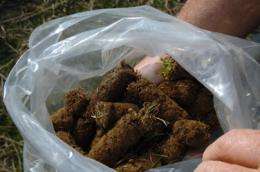Closing the phosphorous-efficiency gap

Ways to reduce the costs of phosphorus fertiliser use on farms – critical for sustaining high agricultural production in many Australian farming systems – have been identified in a new suite of journal papers.
The price for phosphorus is increasing steadily and has doubled over the last 10 years.
Providing a national review of phosphorus use in grazing and cropping systems, Australian and international scientists found that Australia’s pasture systems, on average, have low phosphorus-use efficiency (15-30 per cent) while most broadacre grain operations average around 50-60 per cent efficiency.
They say that the major avenue for addressing inefficiencies and increases in phosphorus fertiliser cost could be addressed through improving fertiliser technologies; breeding plants that can more efficiently take up phosphorous from the soil or grow better in lower-phosphorus soils; and applying the right amounts of phosphorus fertilisers at the right times.
According to Dr Richard Simpson from CSIRO’s Sustainable Agriculture Flagship, with a few exceptions, improvements in using phosphorus efficiently have been stalled for years.
“Ideally we would like to be applying only one kilogram of phosphorus as fertiliser to produce one kilogram of phosphorus in food and fibre products,” Dr Simpson said.
“But for every kilogram of phosphorus that ends up in farm products, usually two to four kilograms of phosphorus has been added to the soil in fertiliser. This is because most Australian soils tend to hold on to phosphorus when they are fertilised and plants can’t access it.
“We really can’t afford to continue doing that. From a dollar point of view, improved efficiency will mean we can reduce costs for our farmers, but also, high-quality phosphorus reserves are a finite global resource – the more effectively we use phosphorus the better global citizens we will be,” Dr Simpson said.
“This latest work is showing us how we may be able to achieve improved efficiency through improved practices and technologies.”
Globally, phosphorus fertilisers are an important input for producing food. For most Australian farms, using phosphorus fertiliser (along with other inputs like nitrogen and water) ensures high production per hectare therefore helping to minimise overhead costs and support more efficient use of land and other resources. This helps Australian enterprises to maximise their returns on investment and maintain their global competitiveness.
“Unfortunately, the price of fertiliser has doubled over the last decade and some meat and wool producers are deciding to forego productivity gains as they need to reduce stocking rates,” Dr Simpson said.
“In addition, the cost of energy needed to source and produce fertilisers is rising, so further steady increases in fertiliser costs are expected.
“The key thing for farmers to think about is whether they are optimising fertiliser application for their production goals. Applying phosphorus amounts that exceed the targets for optimal management simply cost more in fertiliser for no gain.
“If the inefficiency gap can be closed there are big opportunities to maintain high farm productivity with reduced food production costs and reduced phosphorus losses to the environment such as into waterways.
“While it’s not going to be easy, there are immediate steps we can take and there are many improvements possible. Pasture systems particularly provide the biggest opportunity,” he said.
CSIRO’s Sustainable Agriculture Flagship is working with industry and farmers to more efficiently use resources such as nutrients, water, soil and labour to benefit both productivity and the environment.
More information: For online papers published in preparation for a special edition of the journal Plant and Soil see .
Provided by CSIRO
















